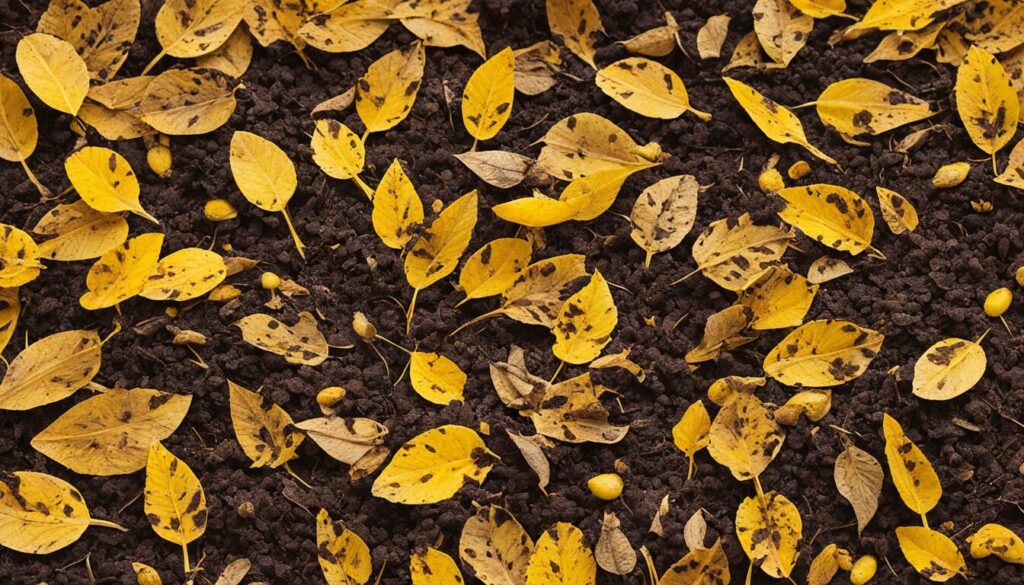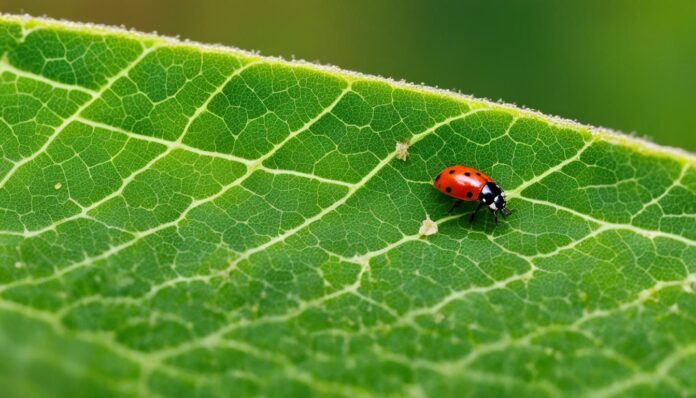Thrips, tiny insects that wreak havoc on gardens, pose a significant challenge for gardeners and plant enthusiasts. These slender pests not only damage plants but also contribute to the spread of plant viruses and diseases. Their small size and elusive nature make them difficult to detect and control, necessitating proactive and informed pest management strategies.
Key Takeaways:
- Thrips are small, slender insects that can cause substantial damage to plants in gardens and greenhouses.
- Identifying thrips can be challenging due to their tiny size, but they can be distinguished by their narrow bodies and fringed wings.
- Thrips damage is characterized by stippling on leaves, distorted petals, and the presence of black specks on plants.
- Integrated pest management strategies, such as cultural controls and the promotion of beneficial predators, are crucial for effective thrips management.
- Maintaining plant health and practicing organic gardening methods can enhance the resilience of plants against thrips infestations.
Thrips Species and Damage
Thrips are a diverse group of insects that can cause extensive damage to a wide range of plants. With thousands of species, thrips have a preference for specific host plants, such as avocados, beans, citrus fruits, greenhouse plants, and flowers. These tiny pests feed on flower petals, buds, and plant tissues, resulting in various forms of damage that include scarring, brown flecks, and distorted leaves.
Identifying thrips can be challenging due to their small size, but they can be distinguished by their slender bodies, fringed wings, and a variety of colors. Accurate identification of thrips species is crucial for effective pest management.
| Common Thrips Species | Preferable Host Plants |
|---|---|
| Avocado Thrips | Avocados |
| Bean Thrips | Beans |
| Citrus Thrips | Citrus fruits |
| Greenhouse Thrips | Greenhouse plants |
| Western Flower Thrips | Flowers |
Thrips damage goes beyond physical harm to plants. These insects can also spread plant viruses and fungal spores, further compromising plant health and yield.
Recognizing Thrips Damage and Symptoms

Thrips damage can be recognized by several symptoms. The most common sign of thrips feeding is leaf stippling, which appears as tiny scars on leaves or fruit. This stippling is caused by the insects puncturing the plant’s epidermal layer and sucking out the sap. As a result, the affected leaves may become papery and distorted.
Furthermore, thrips can also cause damage to flowers, resulting in discolored, pinched, or deformed petals. In some cases, buds may fail to open properly. Additionally, black specks of thrips excrement are often left behind on the leaves or fruit, serving as a visible indication of their presence.
It’s important to note that thrips damage can easily be mistaken for other plant problems, such as nutrient deficiencies or diseases, due to the similarity in symptoms. Accurate identification is crucial to determine the appropriate course of action for effective control.
Another characteristic of thrips is their limited flying ability. As a result, thrips damage may initially appear in a specific location and gradually spread across the plant over time.
To help visualize the symptoms of thrips damage, refer to the image below:
Thrips damage can manifest as leaf stippling, distorted leaves, discolored petals, and black specks of excrement. Recognizing these symptoms is essential for timely intervention and control of thrips infestations.
Integrated Pest Management Strategies for Thrips Control
Integrated pest management (IPM) strategies play a critical role in effectively controlling thrips in gardens. By implementing a combination of cultural controls, beneficial predators, and targeted insecticides, gardeners can reduce thrips populations and prevent extensive damage to plants.
Cultural Controls for Thrips Control
Cultural controls focus on creating an unfavorable environment for thrips and eliminating their alternate hosts. Here are some key cultural practices for thrips management:
- Remove weeds and grasses around garden areas to eliminate alternate hosts for thrips.
- Clean up crop debris, such as onion leaves, after harvest to reduce overwintering sites for thrips.
Encouraging Beneficial Predators
Beneficial predators play a vital role in controlling thrips populations by feeding on their eggs and larvae. Gardeners can attract and promote these predators to their garden by:
- Planting flowering plants that attract beneficial insects, such as ladybugs and lacewings.
- Providing shelter and nesting sites, such as small native plant patches, for predator insects.
- Minimizing the use of broad-spectrum insecticides that can harm beneficial predators.
Insecticides for Thrips Control
When thrips populations become heavy or cultural controls are insufficient, targeted insecticides can be used to knock down the infestations. Here are some effective insecticides for thrips control:
- Insecticidal soaps: These low-toxicity sprays primarily work by suffocating thrips and can be used on a wide range of plants.
- Neem oil: This natural insecticide disrupts the feeding and reproductive cycles of thrips, helping to control their population.
- Pyrethrin sprays: Derived from chrysanthemums, pyrethrin-based insecticides are effective against thrips and other garden pests.
- Biological insecticides: Products containing beneficial microorganisms, such as Beauveria bassiana, can be used to control thrips populations.
It is important to follow the instructions provided by the manufacturer when using insecticides and to apply them during the appropriate times to ensure effective control and minimize harm to non-target organisms.
| Thrips Control Methods | Pros | Cons |
|---|---|---|
| Cultural Controls | – Environmentally friendly – Long-term impact on thrips populations |
– Requires consistent maintenance – May not be sufficient for heavy infestations |
| Beneficial Predators | – Natural and sustainable – Targets thrips at various life stages |
– Predators may not be readily available in all areas – Effectiveness can vary depending on garden conditions |
| Insecticides | – Quick knockdown of thrips populations – Targeted control |
– Potential harm to beneficial insects – Risk of pesticide resistance |
Every garden is unique, and the effectiveness of thrips control methods may vary. Employing a combination of these strategies and adapting them to the specific garden conditions can lead to successful thrips management while minimizing the impact on the overall garden ecosystem.
Best Practices for Thrips Management
In order to effectively manage thrips and ensure the health of your plants, it is crucial to adopt a proactive approach to garden maintenance. Regular inspections and monitoring of plants for signs of thrips damage and the presence of pest clusters are essential. By detecting thrips early on and responding promptly, you can prevent severe infestations and minimize the damage they cause.
Maintaining a clean garden is another important aspect of thrips management. Removing plant debris and practicing good hygiene helps eliminate potential breeding grounds for thrips. Additionally, avoiding overfertilization and providing plants with the right amount of water and nutrients can enhance their overall health, making them more resilient against thrips damage.
Organic gardening practices play a significant role in thrips management and plant health. Instead of resorting to harmful pesticides, consider using natural predators to control thrips. Ladybugs, lacewings, and predatory mites are effective in reducing thrips populations by feeding on their eggs and larvae. Embracing these eco-friendly methods not only helps control thrips, but also contributes to the long-term health of your garden.
By implementing these best practices for thrips management – proactive maintenance, cleanliness, proper nutrition, and organic gardening – you can effectively manage thrips and promote the overall health and vitality of your plants.
FAQ
What are thrips?
Thrips are small, slender insects that feed on a variety of plants and can cause significant damage.
How can I identify thrips?
Thrips can be identified by their small size, slender bodies, and fringed wings.
What are the common signs of thrips damage?
Thrips damage can be recognized by symptoms such as stippling, distorted leaves, discolored petals, and black specks of excrement.
How can I control thrips effectively?
Integrated pest management strategies, including cultural controls, beneficial predators, reflective mulch, and insecticides, can help control thrips.
How can I manage thrips in my garden?
Regular inspections, plant monitoring, removal of plant debris, and organic gardening practices are key to managing thrips in your garden.

